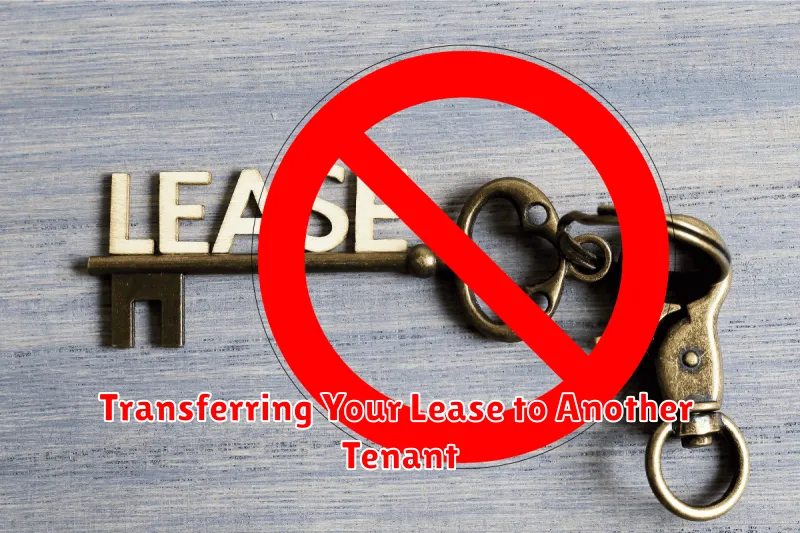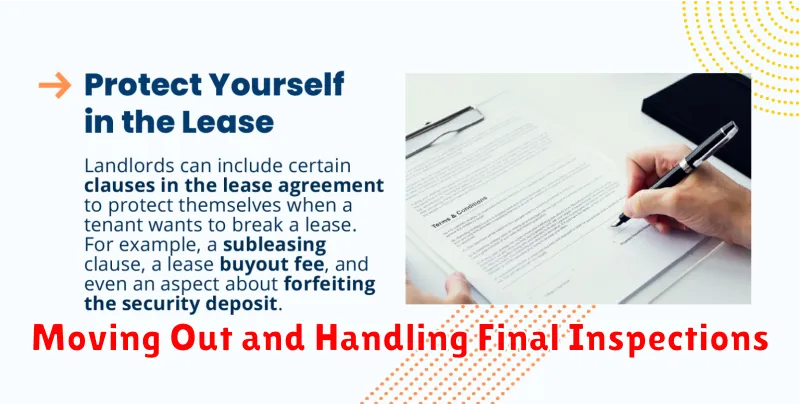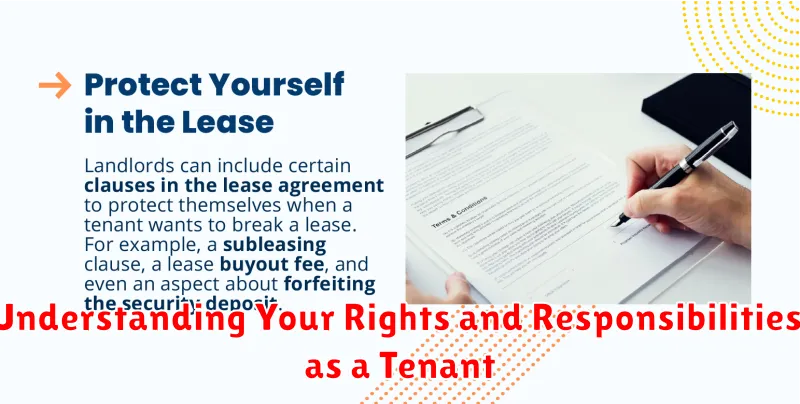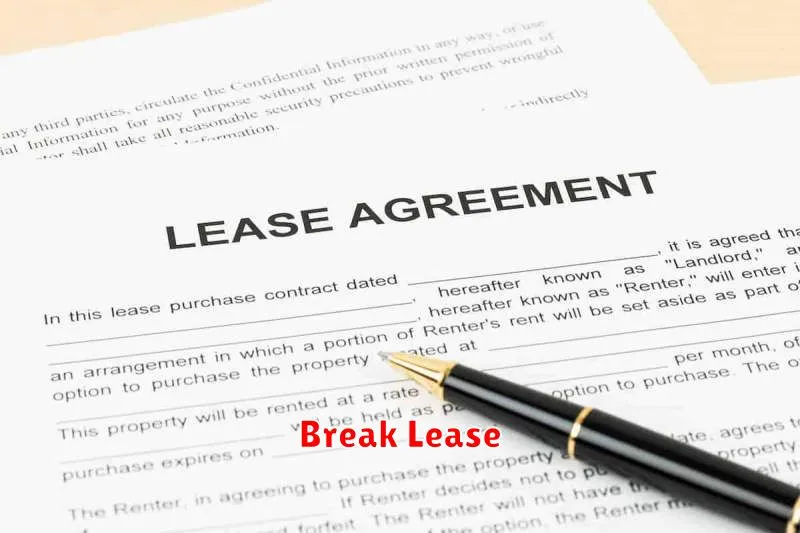Are you stuck in a lease you can’t escape? Maybe your landlord is breaking the terms of the lease, or maybe you just need to move for an unforeseen reason. Whatever your situation, breaking a lease can be stressful and expensive. But don’t worry! This article will explore the legal ways you can break your apartment lease without facing serious financial consequences. We’ll discuss common reasons for lease termination, your rights as a tenant, and how to navigate the process of legally ending your lease. Keep reading to learn how you can break your lease legally and move on to greener pastures.
Understanding Your Lease Agreement Terms and Conditions
Before you even think about breaking your lease, it’s crucial to understand the terms and conditions of your lease agreement. This document outlines the legal agreement between you and your landlord. Carefully reading through the entire document is essential, especially sections about early termination fees, lease-breaking penalties, and specific clauses regarding breaking the lease. Pay close attention to the language used; it’s often very specific and can have legal ramifications.
Key clauses to focus on include:
- Early termination fees: This specifies the financial penalty for breaking the lease before its agreed-upon end date.
- Lease-breaking penalties: These can include financial penalties, legal fees, and even damage claims beyond the standard security deposit.
- Specific clauses related to breaking the lease: This section might outline certain circumstances allowing for lease termination without penalty, such as military deployment, job relocation, or safety concerns.
Understanding these clauses will help you determine your legal options, potential costs, and the best course of action for your specific situation.
Valid Reasons for Breaking an Apartment Lease
Breaking an apartment lease can be a complex process, and it’s crucial to understand your rights and responsibilities. While you may be able to break your lease without penalty in certain circumstances, it’s important to consult with a legal professional to ensure you’re proceeding correctly.
Here are some valid reasons for breaking an apartment lease:
- Military Deployment: If you’re required to relocate for military service, you may be able to terminate your lease without penalty. This is often outlined in your lease agreement or state law.
- Domestic Violence: If you are experiencing domestic violence, your landlord may be obligated to allow you to break your lease without penalty. You may need to provide documentation, such as a police report, to support your claim.
- Landlord Breach of Contract: If your landlord violates your lease agreement by failing to provide essential services or making unauthorized entries, you may be able to terminate the lease. However, this must be a serious breach, and it’s essential to document the issues carefully.
- Health and Safety Concerns: In some cases, if your apartment becomes uninhabitable due to severe health and safety issues, you may be able to terminate your lease. These issues could include infestations, hazardous materials, or significant structural damage.
- Unforeseen Circumstances: While rare, certain unforeseen circumstances, such as a job loss or a major medical emergency, might allow you to break your lease. However, this is often determined by your landlord’s policies and local laws.
It’s important to note that these are just a few examples of valid reasons for breaking a lease. You should always consult with a legal professional or refer to your lease agreement for specific details regarding your rights and obligations.
Reviewing Early Termination Clauses in Your Lease
Before signing your lease, it’s crucial to carefully review the early termination clauses. These clauses outline the conditions under which you can break your lease early and the potential consequences you might face.
The termination fees are often the most significant part of these clauses. They can range from a few hundred dollars to several months’ worth of rent. It’s essential to understand how these fees are calculated, and whether they are fixed or subject to change.
Additionally, the lease should specify the notice period you need to provide before breaking the lease. This is typically measured in days or weeks, and failing to provide sufficient notice could result in additional penalties.
Some leases may also include clauses allowing for “no-fault” termination. These clauses typically allow you to break the lease without penalty if specific circumstances arise, such as a job relocation or a change in family situation. Make sure you understand the exact conditions under which you can use these clauses.
Finally, check if the lease allows for subletting. If you can sublet your apartment, you may be able to avoid paying termination fees if you find a suitable tenant to take over your lease. However, this usually requires the landlord’s approval, and they may have specific criteria for potential subtenants.
By thoroughly reviewing the early termination clauses in your lease, you can understand your rights and responsibilities when it comes to breaking your lease early. This knowledge can help you avoid unexpected fees and potential legal issues.
Negotiating with Your Landlord to Break the Lease
If you need to break your lease, you’re not always stuck with paying the rest of your rent. You may be able to negotiate a settlement with your landlord. The most important thing is to communicate with your landlord as soon as possible and explain your situation.
Here are some strategies you can use to negotiate with your landlord:
Be honest and upfront. Explain your situation to your landlord and why you need to break your lease. If possible, provide documentation to support your claim. For example, if you’re moving for a new job, provide a job offer letter.
Offer to pay a fee. You may be able to negotiate a payment to your landlord to break your lease. The amount of the fee will depend on your specific situation and your state’s laws.
Find a replacement tenant. If you can find a qualified tenant to take over your lease, your landlord will be less likely to object to you breaking the lease.
Be prepared to walk away. If your landlord is unwilling to negotiate, you may need to be prepared to walk away from the negotiation. In some cases, it may be more cost-effective to pay the remaining rent on your lease rather than pay a penalty fee.
Finding a Subtenant to Take Over Your Lease
If you’re looking to break your apartment lease legally, finding a subtenant to take over your lease is a good option to explore. This allows you to escape the lease without incurring penalties. However, not all landlords allow subletting, so it’s important to check your lease agreement. It will specify whether you are allowed to sublet and any restrictions or requirements.
If your lease allows subletting, start by looking for potential subtenants. You can advertise in local newspapers, online classifieds, or on social media. When you find a suitable candidate, you need to get your landlord’s approval. Make sure to be clear about the terms of the lease, such as rent amount, lease duration, and any restrictions. It is recommended to create a sublease agreement that outlines the terms of the subtenancy. This document will protect both you and the subtenant and should include important details about the lease. The sublease agreement should be signed by both you and your subtenant.
Once you have a subtenant, you’ll need to notify your landlord and provide them with a copy of the sublease agreement. The landlord will likely want to run a background check on the subtenant. If your landlord approves the subtenant, you can move out and the subtenant will take over the lease. However, you will still be financially responsible for the lease, so make sure your subtenant is financially responsible and able to fulfill the terms of the lease. If your subtenant defaults on rent or damages the apartment, you will still be held responsible.
Documenting All Communication with Your Landlord
When you’re trying to break your lease, you need to make sure you’re protected. One of the best ways to do this is by documenting all communication with your landlord. This includes emails, letters, phone calls, and even text messages.
When you have a paper trail of your communication, you can use it as evidence if you need to take legal action. This is especially important if you’re trying to break your lease due to breach of contract, such as if your landlord isn’t making necessary repairs or if you’re experiencing a hostile living environment.
Here are a few tips for documenting communication with your landlord:
- Always send emails or letters in writing. This way, you have a record of what you said and when you said it.
- Keep copies of all communication, including emails, letters, and texts.
- If you have a phone conversation, make sure to take detailed notes immediately afterward. This will help you remember what was said and when.
- If you’re sending an email, use a professional tone and avoid using slang or jargon.
- Don’t be afraid to ask your landlord to confirm your communication in writing. For example, if you’re requesting repairs, you could ask them to confirm that they received your request and that they will be taking care of it.
By taking these steps, you can make sure that you’re protected if you need to take legal action to break your lease.
Understanding the Financial Implications of Breaking a Lease
Breaking a lease can have significant financial implications, and it’s crucial to understand the potential costs before you make a decision. While breaking a lease might seem like the easiest solution, it can lead to substantial financial burdens.
One common consequence is the lease termination fee. This fee, outlined in your lease agreement, is a penalty for breaking your contract. It’s typically a percentage of your remaining rent, and can vary widely depending on your landlord and location.
Another potential cost is rent for the remaining term. Even after you move out, you may still be legally obligated to pay rent until the lease expires. This is particularly true if your landlord struggles to find a replacement tenant, especially if the market is slow.
In some cases, you might face additional costs like advertising fees or cleaning charges. Your lease agreement will detail these fees.
To minimize these costs, you should try to find a replacement tenant. Some landlords may waive termination fees if you find a suitable replacement.
It’s also crucial to understand the legal implications of breaking a lease. Your landlord might pursue legal action against you, potentially impacting your credit score and making it difficult to rent in the future.
Breaking a lease is a serious decision that requires careful consideration. Weigh the potential financial and legal consequences before making a decision.
Providing Proper Notice of Your Intent to Vacate
Before you can break your apartment lease legally, you must ensure you provide the proper notice to your landlord. This is a crucial step that helps protect your rights and avoids potential legal complications. The required notice period varies depending on your state and lease agreement. Generally, you’ll need to provide written notice, specifying the date you intend to vacate the premises.
It’s essential to carefully review your lease agreement, as it will contain specific instructions for providing notice. Some leases may specify a particular form or method for delivering the notice, such as certified mail, hand delivery, or electronic mail. Always follow the guidelines outlined in your lease agreement to ensure compliance.
The landlord is legally obligated to accept your notice of intent to vacate, even if they disapprove of your decision. The landlord must return the security deposit minus any deductions for damages beyond normal wear and tear. Failure to comply with the proper notice period could result in financial penalties, such as being charged rent for the remaining lease term.
Mitigating Potential Penalties and Fees
Breaking your lease can result in financial penalties, including rent for the remaining lease term, early termination fees, and potential legal costs. However, there are ways to mitigate these costs, depending on your situation and local laws.
One approach is to negotiate with your landlord. If you have a valid reason for breaking the lease, such as a job transfer or medical emergency, your landlord may be willing to compromise. You can offer to pay a reduced penalty or find a suitable replacement tenant to occupy the apartment.
Another option is to sublet the apartment. However, you should check your lease agreement for restrictions on subletting. Some leases allow subletting with the landlord’s consent, while others prohibit it entirely.
If you’re facing serious financial hardship or an unforeseen circumstance, you may be able to break the lease legally by claiming it’s a constructive eviction. This occurs when the landlord fails to provide essential services or breaches the lease agreement, making the apartment uninhabitable.
Finally, always consult with a legal professional before breaking your lease. They can advise you on your legal rights and obligations and help you negotiate with your landlord.
Protecting Your Security Deposit
Breaking your lease can be a stressful and expensive endeavor. To ensure you protect your security deposit, it’s crucial to follow the proper legal steps. First, consult your lease agreement and ensure you understand the terms for breaking the lease. Additionally, ensure your apartment is in move-out condition. Maintain the apartment in a clean and habitable state, addressing any damage and repairs promptly.
Next, consider the landlord’s right to deduct from your deposit. A landlord can deduct for damages exceeding “normal wear and tear.” Document everything you have done to maintain the apartment, including any repairs or cleaning. Consider taking photographs of the apartment’s condition before moving out to support your case.
Finally, communicate with your landlord in writing. Submit a written notice of your intent to break the lease and clearly explain your reasoning. Maintain a record of all communication, including letters, emails, and text messages. This will strengthen your case and ensure a more transparent process.
By taking these steps, you can significantly increase your chances of getting your security deposit back when breaking your apartment lease legally.
Subletting Your Apartment Legally and Properly

If you’re looking to break your lease, subletting your apartment could be a viable option. This involves finding a tenant to take over your lease for the remainder of the term. However, it’s crucial to understand that subletting isn’t always legal or straightforward. Here’s what you need to know about subletting your apartment legally and properly:
Check Your Lease: The first step is to review your lease agreement carefully. Many leases have clauses that either prohibit or restrict subletting. If your lease prohibits subletting, you’ll need to obtain permission from your landlord to sublet. If your lease permits subletting, make sure you understand the conditions outlined.
Obtain Landlord Approval: Even if your lease allows for subletting, you’ll still need to get your landlord’s approval. This is because they want to ensure that the potential subtenant meets their requirements. This might include a credit check, background check, and income verification. Be prepared to provide your landlord with information about the potential subtenant.
Establish a Sublease Agreement: Once your landlord approves the subtenant, it’s essential to create a legally binding sublease agreement. This agreement should include:
- The terms of the sublease, such as the duration and rent amount
- The responsibilities of both the sublessor and the subtenant
- The process for resolving any disputes
Communicate with Your Landlord: Maintain open communication with your landlord throughout the subletting process. Inform them of the subtenant’s name and contact information, and ensure they understand that you are still ultimately responsible for the apartment and the lease. This helps prevent any potential conflicts or misunderstandings.
Keep Documentation: Keep a record of all communications, approvals, and the signed sublease agreement. This documentation is vital in case of any disputes or issues that arise during the sublease period. By following these steps, you can legally and properly sublet your apartment, providing you with a potential solution to break your lease while mitigating potential legal complications.
Transferring Your Lease to Another Tenant

If you need to break your lease early, one option is to find a suitable replacement tenant and have your landlord approve the transfer. This process, known as lease assignment, allows you to relinquish your lease obligations to a new tenant.
Here’s a breakdown of the steps involved in transferring your lease:
- Check Your Lease Agreement: Review your lease to see if it allows for lease assignments. Some leases have clauses that prohibit them or have specific requirements.
- Find a Suitable Tenant: Find a reliable tenant who meets your landlord’s criteria. Your landlord may have their own qualifications for prospective tenants, such as credit score and rental history.
- Negotiate with Your Landlord: Once you’ve found a suitable tenant, reach out to your landlord and explain your situation. Ask for their consent to transfer the lease. Your landlord might have a fee for approving the transfer.
- Create a Sublease Agreement: Prepare a sublease agreement that outlines the terms of the transfer, including the new tenant’s responsibilities, rent payment, and lease duration.
- Complete All Necessary Documentation: Have both the new tenant and the landlord sign the sublease agreement. Your landlord may require additional paperwork, such as a credit check or application for the new tenant.
Note: Even if you successfully transfer your lease, you may still be held financially responsible for any unpaid rent or damage to the property by the new tenant. Ensure you have a solid agreement in place to protect yourself.
Consulting with a Legal Professional for Advice
Before taking any action to break your lease, it is crucial to consult with a legal professional. A lawyer can provide personalized advice based on your specific circumstances and the laws in your jurisdiction. They can help you understand your rights and obligations under the lease agreement, and explore all legal options available to you.
A lawyer can also help you navigate the complex legal procedures involved in breaking a lease. This may include drafting necessary legal documents, such as a notice to terminate the lease, and representing you in any legal proceedings. By seeking professional legal guidance, you can ensure that you are taking the appropriate steps to break your lease legally and protect your rights.
Moving Out and Handling Final Inspections

Once you’ve broken your lease legally, it’s time to move out. Before you leave, ensure you understand the terms of your lease regarding cleaning and repairs. Make sure to complete all necessary repairs and clean the apartment thoroughly.
Schedule a final inspection with your landlord or property manager. This is an important step, as it allows you to document the condition of the apartment before you leave. Be sure to take photos or videos of any existing damage or wear and tear.
During the inspection, be polite and professional. Point out any repairs that need to be made and make sure they are documented. Request a written confirmation of the inspection and a copy of the final walkthrough report. This documentation will protect you from any unwarranted charges.
It’s also a good idea to keep a record of all communication with your landlord, including emails, texts, and phone calls. This can help you in case of any disputes later on.
Understanding Your Rights and Responsibilities as a Tenant

Before we dive into breaking your lease legally, it’s crucial to understand your rights and responsibilities as a tenant. This knowledge empowers you to navigate potential lease-breaking scenarios effectively.
Your lease agreement is a legally binding contract outlining your responsibilities as a tenant, including paying rent on time, maintaining the property, and abiding by specific rules. It also outlines your rights as a tenant, such as living in a habitable environment free from health and safety hazards.
Understanding your rights and responsibilities protects you. If your landlord violates the lease, you have grounds to take action. Similarly, if you wish to break the lease, you need to be aware of the legal consequences and potential financial repercussions.
It’s always wise to consult with a legal professional if you have any questions about your lease agreement or tenant rights. They can provide personalized advice based on your specific situation and local laws.

